#fastnetrace – The northern jetstream seems to have taken a holiday from Ireland for a few days. This mysterious climatic force - which interacts with the restless brew which develops when large areas of cold and warm air go head to head - has been dominating our weather in a very malignant way for most of the summer, squatting over Ireland like a hostile presence. But for now and much of next week, we're in a benign loop, with a decaying bit of the stream to the south, and a disconnected bit weaving away to the north.
It's not before time. Yet despite its domination of the first half of the season, the Dun Laoghaire to Dingle Race in June managed to get through before the Evil One noticed what was happening. But that said, the D2D was slotted in between some violent bursts of meteorological mayhem. Equally, the Volvo Dun Laoghaire Regatta in July managed to get away with it, though it was touch and go for a day or two. However, foul conditions have blown out - or at least seriously impaired - events as various as the Aran Islands Cruise in Galway Bay on the Atlantic seaboard, the annual Lambay Race at Howth on the East Coast, and the Optimist Europeans across channel at Pwllheli. As for the boats coming across from America in the Transatlantic race in July, it was wet, wet and wet again - and hyper-windy too.
But now the jet stream seems to have jetted away, or streamed on, or done whatever it does when it has finally flogged itself to bits. What's left of it is no longer above us, so we've nice fresh Atlantic weather out to the west for our enjoyment, while to the eastward are high-humidity cloudburst conditions which have been putting the dampener on Cowes Week for a day or two.
The improving outlook may be welcome for shore dwellers tired of being buffeted by wind, rain and cold. But there's a lack of vitality in the current weather scenario which is unwelcome for thousands of Fastneteers all psyched up and ready to go around the Solent. The 90th Anniversary Fastnet Race lines up tomorrow at Cowes with a really impressive international fleet of maybe as many as 387 boats including dozens of the hottest craft racing today, and a goodly flotilla of Irish boats among them. Yet it seems quite likely they'll find that the supposedly rugged and windy 608-mile course may be no more than a great big pussy cat. W M Nixon tries to cast the runes on the most unpredictable Fastnet for many a year.
As Confucius didn't say, the trouble with prediction is that it involves the future. Yet almost all the weather forecast sources seem to agree that there won't really be a lot of wind along the Fastnet course for the week ahead. It's difficult to believe without some reservation. Things have a way of going haywire. With a mega heatwave over Europe to the east, and a North Atlantic Ocean which is two to three degrees colder than it should be at this time of the year out to the west (Global Warming how are you?), not even heaven itself will know just what peculiar energy might develop between them.
Who knows, but maybe a sort of doldrum belt will settle in, which will drive everyone crazy, as the doldrums usually bring long but irregular calms and fitful puffs of wind, interspersed with monumental slow-moving downpours from which may come sudden bursts of wind blowing every which way.
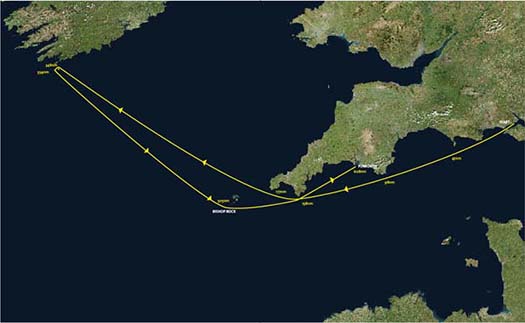
The classic course may not get the good breeze it needs to give of its best, but with a fleet of 380-plus it will be a fascinating contest.
It doesn't sound like the classic Fastnet Race scenario of a good tough beat down Channel into Atlantic sou'westerlies, then maybe sheets just cracked to make out north of the Isles of Scilly for the turn at the rock, with mostly downwind stuff thereafter to at least the Bishop Rock west of the Scillies, maybe even carrying the fair breeze the whole way to the finish at Plymouth. But if we do accept that there are going to be light winds for quite a few days yet – and don't forget that total flat calm has already caused the complete cancellation of a day's racing at Cowes Week - then we have an Irish certain favourite for the Fastnet Race.
The only trouble is that she's not doing the final tuning down in the Solent today. She's not even entered. On the contrary, she's sitting resting in the boatyard at Howth Yacht Club. Step forward Crazy Horse, the one-off Mills 36 owned by ICRA Commodore Nobby Reilly and Alan Chambers. In winds up to ten knots at the ICRA Nationals/Sovereigns Cup at Kinsale at the end of June, the Horse was unbeatable. But anything much fresher, and it seemed – as has been shown at other regattas – that she might as well not leave her berth to go out racing. Yet if we could wave a wand and transport Crazy Horse instantly to Cowes and have her sitting there race-ready, we'd have a serious contender.
However, with so little wind and it all over the place, weather and tactical expert Ian Moore – who master-minded the fabulous win by Bryon Ehrhart's Reichel-Pugh 63 Lucky in the Transatlantic – favours two scenarios. From Carrickfergus, but now based in Cowes, Moore reckoned yesterday that the winner of the Rolex Fastnet 2015 is likely to be either one of the big 'uns, or else one of the smallest lowest rated boats, with the latter being favoured with sou'westers possible from Wednesday onwards
His thinking is that a biggie could win because even in the lightest airs, once they get going they seem to create their own breeze, the sheer height of their masts is such that they're finding wind when dumpier rigs are totally becalmed, and their extra basic speed means that they can break through tidal gates with no more than a zephyr, whereas the lowlier breeds come to a complete halt and have to kedge.
Nevertheless, if total flat calm descends – which is perfectly possible, though Moore agrees that the underlying situation of cold to the west and hot to the east is so volatile that everyone has to expect the unexpected – then the lowest-rated boats such as Brian O'Sullivan and Frances Clifford's veteran Oyster 37 Amazing Grace from Tralee are in with more than a shout.
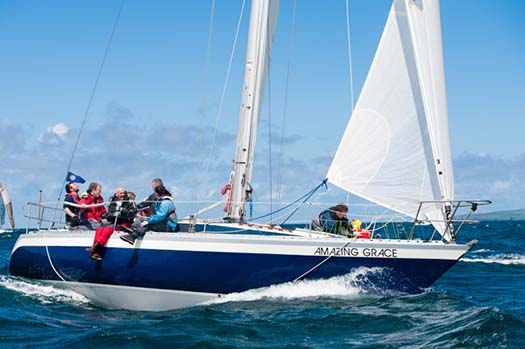
Thanks to her low rating, Amazing Grace was able to come from behind in a new breeze and win the 2013 Dun Laoghaire to Dingle race, and her Tralee Bay crew have high hopes for something similar in tomorrow's Fastnet. Photo: Robert Bateman
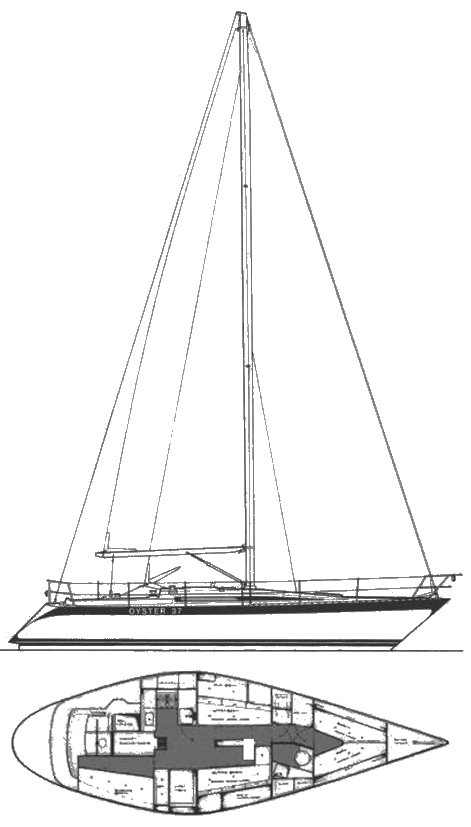
The Oyster 37 is very much a boat of her time, but if you're going to sit becalmed for a long period and gaining all the time if everyone else is becalmed too, then it's surely better to do it aboard a comfortable boat like this rather than some stripped-out little racer.
It had all become decidedly academic for Moore at the time of writing on Friday, as his own Fastnet programme had to be scrubbed on Thursday night. He'd been navigating the America mini-maxi Bella Mente to notable success in Cowes Week with a win in the Britannia Cup on Tuesday and a third in the New York Yacht Club Cup on Thursday. But on Thursday night the 70-year-old owner Hap Fauth – who operates on the boat as a very competitive owner-driver – had to suddenly take off back to America to sort out a big business deal, and Bella Mente was withdrawn from the Rolex Fastnet 2015.
Moore seemed very philosophical about it all yesterday, and his remarkable talent is well booked up in the months ahead. But nevertheless it wouldn't be surprising if, by this morning, he has already been enticed into another's navigator's berth, though maybe his contract with Fauth precludes this. Just the same, if you happen to have that magic wand which will get Crazy Horse to Cowes, we might have the very man to navigate for you......
The absence of Bella Mente leaves the way more open for Lucky to do her thing. Previously known as Loki and owned by Stephen Ainsworth, she won the Sydney-Hobart under Gordon Maguire's guidance and was a class winner in the Hobart race on another occasion, as well as sweeping the board in the Australian national offshore series for three years running. She is one utterly exceptional boat, designed by Reichel Pugh and built by McConaghy in Australia. And yes, you're right - the Volvo 70 Green Dragon was also designed by Reichel Pugh and also built by McConaghy, but in China. Go figure.

Designed by Reichel Pugh and built by McConaghy in 2010, the 63ft Lucky is a winner, though in the Fastnet she cannot expect the winds she is racing with as seen here in the Sydney-Hobart, when she was known as Loki.
But if biggest really is best, then the hundred footers such as the Kenny Read-skippered Comanche simply have to be out in front, but the "big fat girl" has shown that she really does need a bit of bite to the breeze to sail anywhere near her rating, so the smart money will be going the way of George David's latest boat, Rambler 88. The 88-footer has shown she's swift enough to keep snapping at Comanche's heels, yet as she's a slimmer configuration, she can give a very good account of herself in lighter airs.
For George David, it's all very special, as he hasn't done the biennial Fastnet since 2011, when his boat Rambler 100 snapped her keel just after rounding the rock, with the wonderful maritime spirit of Baltimore and West Cork giving of its best to successfully save the crew from potential tragic disaster. Regardless of how she's doing in the race, it's going to be quite a moment when Rambler 88 comes round the Fastnet Rock.
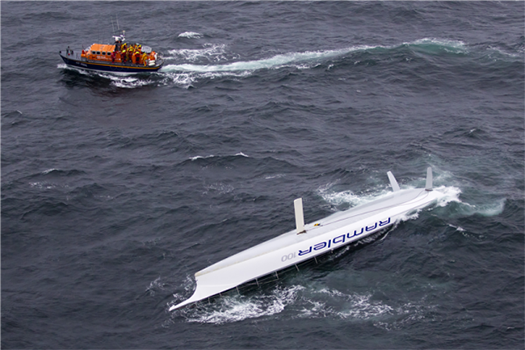
Fastnet Race of 2011, and Rambler 100 has capsized off West Cork when her keel fractured after rounding the rock
Ireland has had a good record in the Fastnet over the years with several excellent class placings since the great race was inaugurated in 1925, and then in 2007 the moon and stars were all in alignment when Ger O'Rourke's Cookson 50 Chieftain from Kilrush came in to the finish in Plymouth in the evening light and was soon sitting pretty as first overall. And it stayed that way, with Chieftain also becoming the RORC "Yacht of the Year".
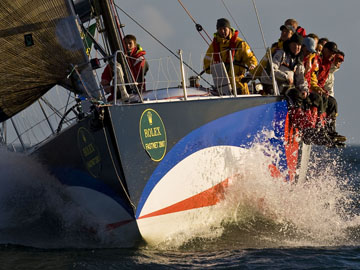
Fasthet Race of 2007, and Ger O'Rourke's Cookson 50 Chieftain comes in out of the ocean, on her way to winning overall.
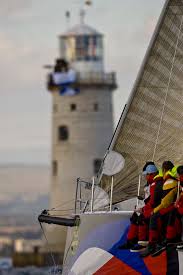
The magic moment. Chieftain closes in on the finsh line in Plymouth for total victory in 2007.
Two years later Mick Cotter's handsome Southwind 78 Whisper gave a very good account of herself with a masterly reading of the final thirty miles of the beat to the rock, slotting into a wind shift with perfection to come in on starboard tack as neat as you please well ahead of her nearest rivals to place this comfortable cruiser-racer a very creditable fifth overall in an era when being in the top twenty in the Fastnet is a real achievement, even for a flat-out racing machine, yet Whisper cruises with comfort.
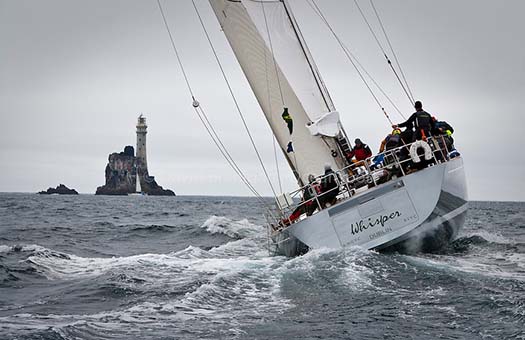
A tack called to perfection. By breaking away to the north, and then closing in on the Fastnet on starboard, Mick Cotter's comfortable performance cruiser Whisper got herself up to fifth overall in the 2009 Fastnet Race
More recently we've had Anthony O'Leary with his silver Ker 39 Antix (since sold to the Baltic) becoming RORC Yacht of the Year 2014 for the Commodore's Cup win, this year in the Fastnet he's racing the red Ker 40 Antix with his son Olympian Peter back on the strength - earlier in this international season, Peter had been dutifully absent back in Cork, involved in the final stages of making the old fellow a grandfather.
The total Irish lineup to the best of our knowledge (though we'll be more than happy to be proved wrong if some overlooked Irish boat does well) is:
Amazing Grace, (Oyster 37, Brian O'Sullivan & Frances Clifford, Tralee Bay SC)
Antix (Ker 40, Anthony O'Leary Royal Cork YC),
Artemis 23 (Figaro II, Andrew Baker, Quoile YC)
Big Deal (Dehler 34, Derek & Conor Dillon, Foynes YC),
Desert Star (Sunfast 37, Ronan O'Siuchru, Royal St George YC)
Endgame (A35, Frank Doyle, Royal Cork YC),
Jet Dream (J/105, Philip Bourke, Mayo SC),
Katsu (Reichel-Pugh 45, Alan Hannon, Royal Ulster YC),
Kilcullen Voyager (Open 60 Enda O'Coineen, Royal Irish YC),
Plus that list, RORC Commodore Michael Boyd of Dun Laoghaire will be racing the Grand Soleil 43 Quokka 8 in partnership with Peter Rutter. And for those taking a punt, don't be put off by the glamour of the international superboats sailed by rock stars. Everyone is in with a chance – don't forget that the overall winners of the Rolex Fastet Race 2013 were the French father and son crew of Pascal and Alexis Loison racing the JPK 10.10 Night And Day, a mighty appropriate name as they were sailing in the Two-Handed division as well, making it definitely one for the books.
But in a deeper way, maybe the most remarkable thing about tomorrow's huge fleet, heading westward down the Solent from noon onwards in a seven stage start, is that it will include three superbly-restored and maintained Sparkman & Stephens classics which encapsulate a whole generation of offshore and ocean racing development.
There's the 52ft Dorade (Matt Brooks) which won the Fastnet in 1931 and again in 1933, there's the 53ft Stormy Weather (Christopher Spray), Fastnet winner of 1935, and there's the 1948-built 57ft Argyll (Gryff Rhys Jones) which won the Bermuda Race in 1950.
A study of their hull shapes is intriguing for they reveal that Olin Stephens, while producing beautiful boats, was quite conservative in his early hulls for ocean racers – both Dorade and Stormy Weather look as if they were intended for a schooner rig, which is very American, whereas on this side of the Atlantic purpose-designed offshore racers already had a marked toe to their keels to give a better shape for windward work, as seen in the Fife-designed Hallow'en of 1926, the Fastnet line honours winner which set a course record which stood for thirteen years.
But the Americans were light years ahead in terms of rig and sails, and in the case of Sparknan & Stephens, it was the technical input of young Rod Stephens (barely out of school when Dorade first crossed to win the Transatlantic and the Fastnet in 1931) which gave them this distinct edge.
It was so clearcut that when the great Carleton Mitchell decided to build a new boat for the 1956 Bemuda Race, he placed the design commission with Olin Stephens rather than his former designer Philip Rhodes, not because he thought he'd get a hull shape which was any faster, but because he knew Rod Stephens would be quietly masterful in over-seeing the rig. The result was the 38ft yawl Finisterre, which won the biennial Bermuda race overall in 1956, and again in 1958, and yet again in 1960.
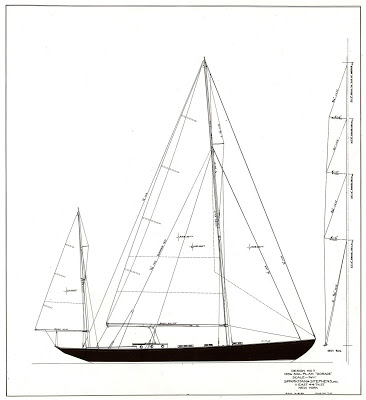
While the sailplan of Dorade was fairly radical for an offshore racer in 1931...

Her hull profile was quite conservative, in fact it hinted at a classic American schooner yacht
Yet over and above Rod's technical genius, when Olin Stephens was on top form he produced lovely looking boats, and Dorade, Stormy Weather and Argyll are gorgeous looking yachts. The fact that all three are racing in the Fastnet tomorrow take us into the realms of mythology. And who knows, but they might be in with a shout in the results with this crazy weather scenario. They're ready to pounce, they can give a good showing of themselves. Gryff Rhys Jones found to his delighted astonishment that Argyll had placed first in class and fourth overall in the 154-boat fleet in the recent Cowes to St Malo Race. After all those years banging about in show business, the boy finally done good by taking on the custodianship of Argyll. And now the Fastnet beckons.
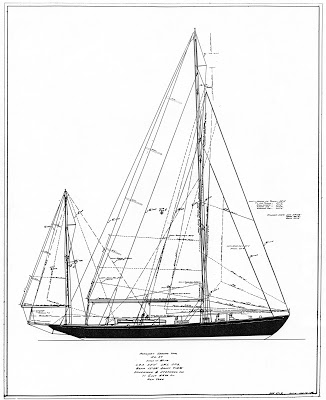
Stormy Weather (1935) defined the style of the mid-20th Century American yawl, though later boats tended to masthead rig
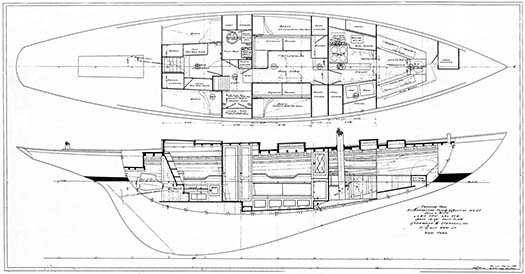
Stormy Weather continued the conservative style of Dorade's hull profile, though she was beamier. The heavily raked rudder enabled her to be tiller-steered with the tiller comfortably within the cockpit, but an angle like that reduced the rudder's directional control and created drag unless the boat had her sails trimmed for perfect balance

One of the most handsome of Olin Stephens' creations, Argyll was built in 1948
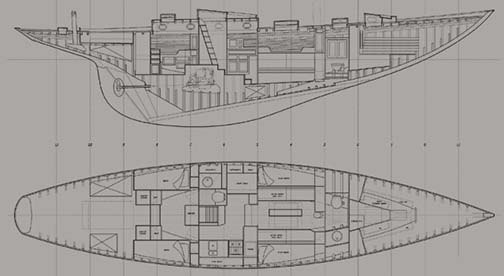
While the style of Argyll's accommodation has been retained, an uograde by the late Ed Burnett saw the galley being moved aft from its oirgnal position forward of the mainmast
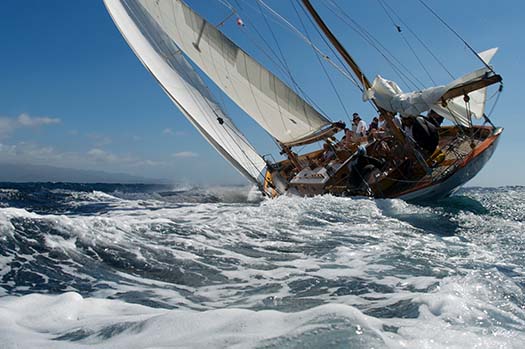
Timeless style, elegant power. Argyll in a breeze of wind off Corsica
































































